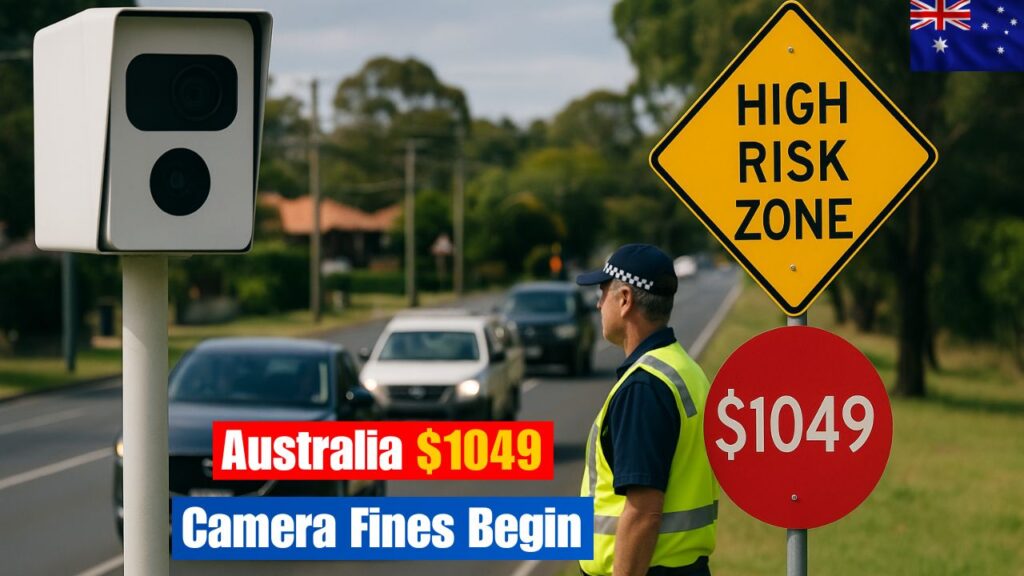The Australian government is rolling out a significant update to traffic enforcement with a new camera rule taking effect on 30 November. Drivers caught breaking the law in designated high-risk zones across the country will face immediate fines of $1049. This change is designed to cut down on speeding and distracted driving while reducing road deaths. The system uses upgraded cameras with AI technology that can spot violations in seconds. As Australia pushes forward with better road safety measures, drivers need to learn how these new rules operate and which locations will see the most enforcement when the policy starts at the end of November.

Australia’s New Camera Rules Enforce Instant Driver Penalties from 30 November
The new traffic camera enforcement rule represents a major change for Australian drivers who regularly drive through areas with high accident rates. This rule brings in advanced cameras with high accuracy that can instantly detect speeding and violations such as phone use and running red lights. When a vehicle triggers the system it will automatically receive a $1049 fine which limits opportunities for disputes or delays. Australian drivers should be aware that these upgraded systems work continuously throughout the day & night to provide constant monitoring across major cities and regional highways as well as suburban areas. Since road safety remains a national priority this update aims to make drivers more aware of their behavior behind the wheel.
High-Risk Zone Speeding in Australia Now Triggers $1,049 Instant Fine
The updated penalty system targets dangerous areas throughout Australia by focusing on roads that have recorded high numbers of accidents or traffic violations over time. State transport departments have used years of collected information to identify these locations. The immediate $1049 fine aims to prevent dangerous driving in places where safety concerns are most serious. Drivers who pass through school zones and busy intersections as well as dangerous curves and areas known for speeding will experience increased monitoring. Australian authorities have stressed that this change serves a purpose beyond generating revenue. The system is designed to safeguard drivers and cyclists along with pedestrians by using automated enforcement to discourage risky driving behavior.
| Zone Type | New Fine Amount |
|---|---|
| High-Risk Accident Zones | $1,049 Instant Fine |
| School Zone Violations | $1,049 Fine + Demerit Points |
| Mobile Phone Detection | $1,049 for First Offence |
| Red-Light Camera Triggers | $1,049 Standard Penalty |
| Speeding Over Limit | $1,049 for Major Classifications |
Stricter Australian Road Monitoring Begins — New Camera Laws Effective Nationwide
Australian citizens need to get ready for increased surveillance as law enforcement agencies install more AI-powered cameras across the nation. These cameras do more than just catch speeding violations. They also identify drivers not wearing seatbelts properly and those using mobile phones while driving & performing dangerous overtaking maneuvers. The new regulation is designed to close gaps in the system & remove inconsistent enforcement by making the entire process automatic. Officials think that applying penalties uniformly will lead to lasting changes in driver behavior particularly in locations where high-speed accidents happen frequently. The cameras connect straight to state databases so fines get sent out almost immediately after an offense is detected. This means Australian drivers need to be more careful than ever about following road rules in their daily travels.
Australian Drivers Face Tougher Compliance Measures Under New Road Safety Policy
Road safety measures for Australians are getting stronger with the new traffic camera rule. The changes include better signs in dangerous areas and more public awareness programs. There will also be extra mobile enforcement units working with the fixed cameras. These efforts aim to reduce road trauma incidents that continue to be a major problem across the country. Authorities want to promote safer driving through tough penalties & better monitoring. The goal is to prevent accidents that can be avoided in cities and regional parts of Australia.




